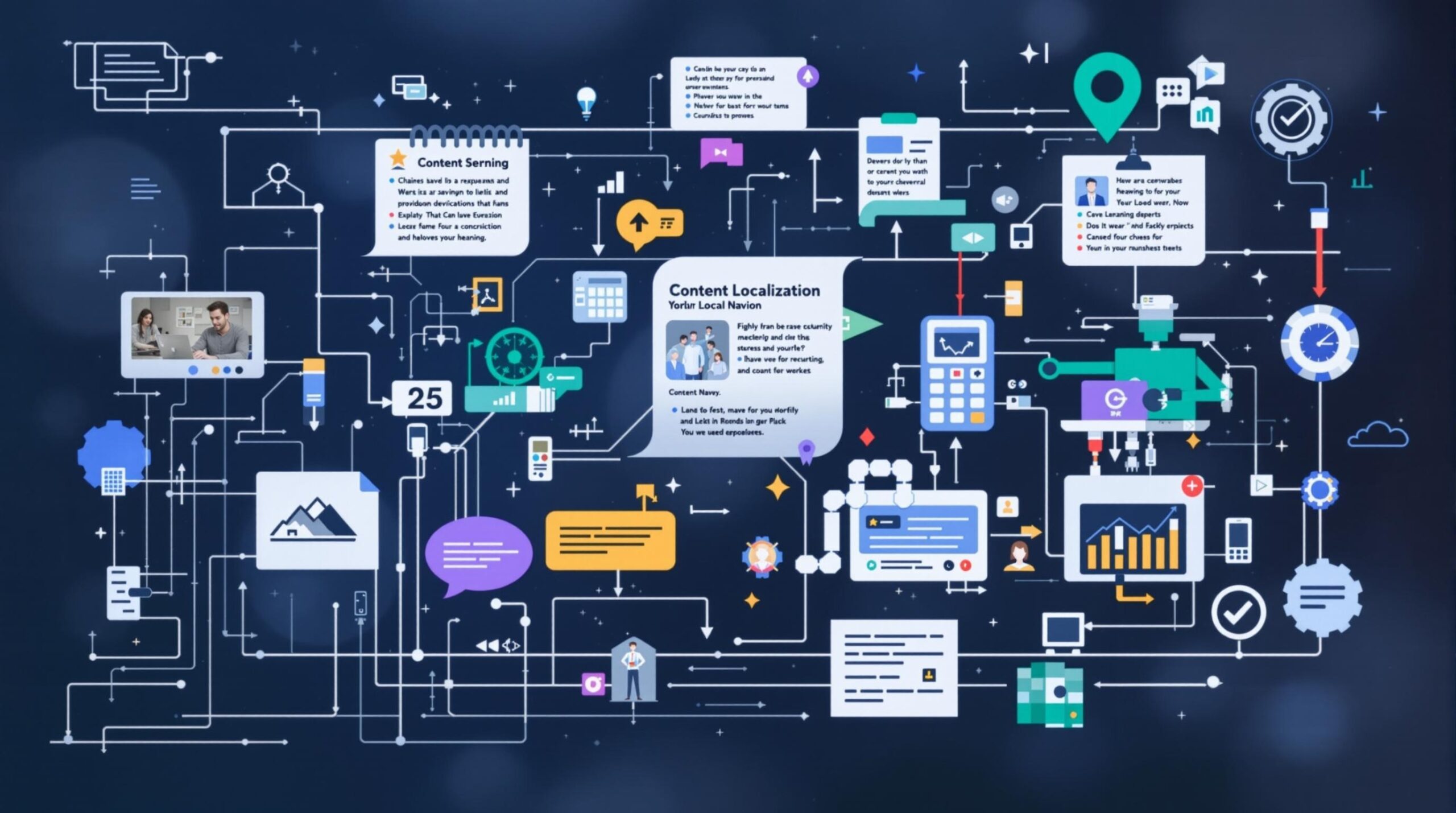The Beginner’s Guide to Automating Your Content Localization
Content localization automation has emerged as a critical component for businesses seeking to expand their global reach while minimizing costs and maximizing efficiency. By implementing strategic automation processes, companies can transform their content for international audiences without the traditional bottlenecks associated with manual localization workflows.
Key Takeaways:
- Automated localization can reduce translation timelines by 50-70% compared to manual processes
- 55% of global consumers only buy from websites in their native language, highlighting the business necessity of localization
- Companies can achieve 30-40% cost savings by implementing localization automation tools
- A well-structured localization strategy requires cross-functional teams and careful content prioritization
- Modern AI translation tools can handle cultural nuances, not just word-for-word conversions
Why Localize Your Content? Understanding the Business Case
Content localization goes far beyond simple translation. It’s the comprehensive process of adapting your content linguistically, culturally, and technically for different target markets. This adaptation ensures your message resonates authentically with each audience you’re trying to reach.
The business case for content localization is compelling. With 55% of global consumers purchasing only from websites in their native language, and 72% prioritizing localized sites when making buying decisions, companies that ignore localization do so at their own peril. The impact on key performance metrics is equally impressive – localized campaigns achieve 86% higher click-through rates, while websites adapted for local markets see 47% more search traffic.
Apps that fail to localize lose approximately 13% of potential users, while localized advertisements generate six times higher engagement. With the language services sector projected to grow at a 5.3% CAGR through 2026, the time to implement an effective global marketing automation strategy is now.

The Bottom-Line Benefits of Automation
The contrast between manual and automated localization workflows is stark. Manual processes are time-intensive and error-prone, while automation delivers real-time updates through CMS integrations. This shift in approach yields significant efficiency gains, with automated systems reducing translation timelines by 50–70% and enabling simultaneous updates across multiple languages.
The financial impact is equally impressive. Companies save between 30–40% on localization costs by minimizing manual labor and rework. This cost reduction doesn’t come at the expense of quality either. Modern AI translation tools can now parse cultural nuances, adapt idioms, and correctly format dates according to regional standards.
Perhaps the most compelling benefit is scalability. Automation allows businesses to manage ten times more content without proportional increases in cost, making it possible to expand into new markets while scaling content creation efficiently. For growing companies, this capability is invaluable for maintaining consistent brand messaging across global audiences.
Building Your Localization Automation Strategy
An effective localization automation strategy starts with assembling the right team. Your localization team should include designers who can create culturally relevant visuals, developers for necessary code adjustments, marketers to oversee regional campaigns, and product managers to coordinate deadlines and deliverables.
Setting clear goals is crucial. Establish market-specific KPIs, such as improving feature adoption by 20% in Spanish-speaking regions or increasing conversion rates by 15% in Asian markets. These targeted objectives help measure the effectiveness of your localization efforts.
Collaboration tools are essential for synchronizing workflows. Integrations with platforms like Slack and Jira enable team members to communicate effectively across departments and time zones. Case studies show that well-aligned teams can reduce deployment errors by up to 35%.
Consumer preference data further reinforces the importance of this strategic approach. With 87% of consumers avoiding English-only sites, implementing a comprehensive localization strategy is no longer optional for businesses with global aspirations.
Content Prioritization and Inventory
Before diving into localization, I recommend conducting a thorough content audit. Tools like Screaming Frog can help identify high-traffic pages and extract valuable metadata, Google Analytics metrics, and backlink data. This information forms the foundation of your content prioritization strategy.
A tiered localization approach allows you to focus resources where they’ll have the greatest impact. Consider these prioritization factors:
- Traffic volume from target regions
- Conversion influence (some product guides have 70% conversion influence)
- Backlink profiles (using tools like Ahrefs)
- Update frequency requirements
- Technical complexity of content
Don’t overlook offline content in your inventory. Approximately 20% of critical content exists outside websites, including presentations, support scripts, and marketing materials. These elements require careful tracking within your content inventory.
For effective inventory management, document word counts, update frequencies, and regional priorities for each content piece. This methodical approach ensures nothing falls through the cracks as you streamline your content repurposing across markets.
Essential Localization Automation Tools
The right tools can dramatically enhance your localization efforts. Here are some leading platforms to consider:
Centus stands out as the best all-in-one platform for small to medium enterprises. Starting at $120/month, it offers AI translation capabilities and automatic content snapshots that simplify the localization process for beginners.
For enterprise-level operations, Lokalise provides advanced automation features including pseudolocalization and QA tools. At $825/month for 30,000 words, it delivers enterprise-grade reliability with 99% uptime.
Weglot specializes in website translation with live previews, making it ideal for e-commerce and content-heavy sites. At $990/year for 10,000 words, it offers good value for businesses with moderate content volumes.
When selecting a tool, consider these key factors: uptime guarantees, integration capabilities (particularly with GitHub, Figma, and your CMS), learning curves, budget constraints, content volume, and specific technical requirements. The ideal solution will align with your unique content automation strategy and business goals.
CMS and API Integration for Automated Workflows
Integrating your content management system with localization tools creates powerful automation opportunities. Modern CMS platforms can be configured with automatic triggers that detect content changes and route them to translators through platforms like Centus.
Dynamic publishing capabilities take automation to the next level. By combining tools like Make with AI translation tools such as DeepL Translate, businesses can deploy localized content across multiple sites in seconds rather than days. Some companies have successfully launched eight localized sites in under 30 seconds using these integrations.
API workflows can be further optimized with CDN solutions like Cloudflare Workers, ensuring localized content loads quickly for users around the world. However, be aware of potential integration challenges, such as date format mismatches that may require post-editing.
System compatibility considerations are crucial when designing your automation workflow. Ensure seamless connections between your CMS, translation tools, and publishing platforms by thoroughly testing integrations before full-scale implementation.
Measuring Success and Scaling Your Localization Efforts
Tracking ROI is essential for justifying continued investment in localization automation. Monitor engagement metrics across different locales, including bounce rates, time on page, and conversion rates. Compare these figures against your pre-localization baseline to quantify improvements.
Quality assurance should combine automated checks with human oversight. Automated tools can identify technical issues, while native speakers can review content for cultural appropriateness and linguistic accuracy. This hybrid approach ensures both efficiency and quality.
Implement a continuous improvement cycle by establishing feedback loops from local markets. Regular input from regional teams or customers can help refine your localization approach over time.
As your localization program matures, develop expansion strategies based on market performance data. Add languages strategically, prioritizing markets with the highest potential return on investment.
Finally, future-proof your localization infrastructure by preparing for content volume increases and new market entry. Choose scalable tools and processes that can grow with your global marketing automation needs.
Sources
Gridly – 5 Ways to Automate Content Localization
POEditor – Localization Automation
Phrase – Top Benefits of Localization Automation
Lokalise – Content Localization
Make – How to Use AI to Automate Website and Blog Localization
Centus – Content Localization
OneSkyApp – Localization Statistics
Centus – Best Localization Platforms








